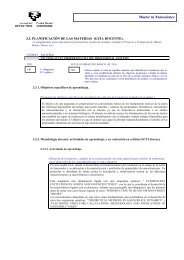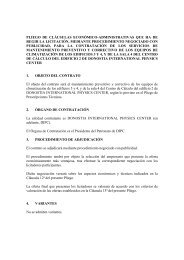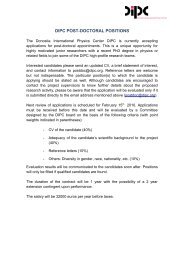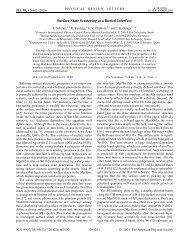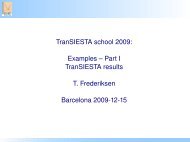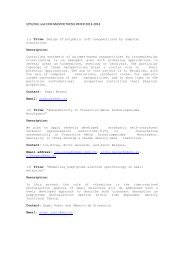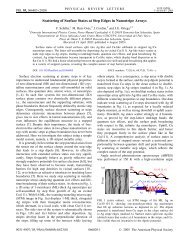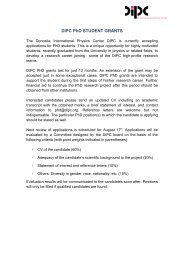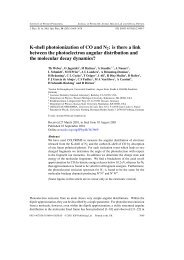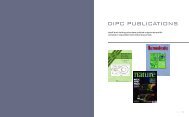Dynamic screening and electronâelectron scattering - Donostia ...
Dynamic screening and electronâelectron scattering - Donostia ...
Dynamic screening and electronâelectron scattering - Donostia ...
You also want an ePaper? Increase the reach of your titles
YUMPU automatically turns print PDFs into web optimized ePapers that Google loves.
V.M. Silkin et al. / Surface Science 601 (2007) 4546–4552 4547<br />
[17]. In this study it was proven that e–e <strong>and</strong> the e–ph<br />
mechanisms are equally important for the hole decay for<br />
1 ML coverage. Very recently a joint experimental <strong>and</strong> theoretical<br />
investigation of electron dynamics for Cs <strong>and</strong> Na<br />
adlayers on Cu(111) was performed as well [18]. Here,<br />
we investigate the energy dependence of the e–e contribution<br />
for several positions of the QWS b<strong>and</strong> relative to the<br />
Fermi level E F , which, in turn, depends on the Na coverage.<br />
For the sake of comparison with the experiment, a reasonable<br />
assumption could be that the e–ph contribution<br />
should not change significantly for such small variation<br />
of the QWS energy.<br />
As a second case study, we analyze dynamic <strong>screening</strong><br />
properties in metal clusters. In clusters <strong>and</strong> nanoparticles,<br />
chemical, optical, <strong>and</strong> electronic properties can be tuned<br />
by varying the size <strong>and</strong>/or the shape of the system. Besides<br />
its fundamental interest, tailoring the electronic properties<br />
can be of vast importance for many processes of technological<br />
interest, such as photochemical reactivity. Over the last<br />
years, the advent of femtosecond lasers has fueled the<br />
experimental study of electron relaxation processes. Particular<br />
attention has been paid to the dependence on size of<br />
the electron–electron interaction processes [19–21]. We will<br />
show that the interplay between <strong>screening</strong> effects <strong>and</strong> space<br />
localization of the initial excitation makes the lifetime of<br />
the excitation vary with respect to the bulk equivalent.<br />
2. Theoretical methods<br />
In very recent years, improvements in experimental<br />
methods, in particular in the field of ultrafast laser spectroscopies,<br />
are making it possible to study electronic excitations<br />
at time scales below the femtosecond [22,23]. In this<br />
time scale, the <strong>screening</strong> of excited electrons in condensed<br />
matter can be incomplete <strong>and</strong> the description of the electronic<br />
excitations as quasiparticles is questionable [24].<br />
However, most st<strong>and</strong>ard experimental techniques provide<br />
information on time scales for which the <strong>screening</strong> of excited<br />
electrons can be approximated as instantaneous in<br />
practice. In this case, the description of the many-body<br />
electronic excitation can be simplified by means of the quasiparticle<br />
picture. In the following, we focus into this<br />
situation.<br />
The <strong>scattering</strong> rate of an excited electron or hole due to<br />
inelastic e–e <strong>scattering</strong> can be evaluated by means of<br />
many-body calculations based on the electronic self-energy<br />
[25,26]. In this approach the lifetime broadening of a quasiparticle<br />
in a quantum state characterized by an energy E 0<br />
<strong>and</strong> wave function w 0 is obtained as the projection of the<br />
imaginary part of the self-energy R(r,r 0 ,E 0 ) onto the state<br />
itself (atomic units are used throughout, i.e., h = e 2 =<br />
m e = 1, unless otherwise is stated)<br />
Z Z<br />
C e–e ¼ s 1<br />
e–e ¼ 2 drdr 0 w 0 ðrÞImRðr; r0 ; E 0 Þw 0 ðr 0 Þ: ð1Þ<br />
Frequently the self-energy R is represented by the so-called<br />
GW approximation [25], which is the first term in a series<br />
expansion of R in terms of the screened Coulomb interaction<br />
W. Usually, the non-interacting Green function G 0 is<br />
used to replace the full one-electron Green function G. In<br />
the following we provide a brief description of the numerical<br />
methods used in the calculation of <strong>scattering</strong> rates in<br />
the two examples considered in this work, namely, quantum<br />
well states at metal surfaces <strong>and</strong> metal clusters. A more<br />
detailed account can be found elsewhere [26,27].<br />
2.1. Quantum well states<br />
In the case of Na adlayers on the Cu(111) surface, we<br />
assume that the charge density <strong>and</strong> the one-electron potential<br />
only vary along the z-direction perpendicular to the<br />
surface <strong>and</strong> are constant in the (x,y) plane parallel to the<br />
surface. This assumption is valid for Na induced QWS’s<br />
at coverage rates close to 1 ML, since the wave functions<br />
lie mainly in the Na layer <strong>and</strong> in the vacuum side, i.e., in<br />
a region with little potential variation in the direction parallel<br />
to the surface [28]. This leads to significant simplification<br />
of Eq. (1), which now takes a form<br />
C e–e ¼ s 1<br />
e–e ¼ 2 X 0<br />
f<br />
Z<br />
Z Z dqk<br />
ð2pÞ 2<br />
dzdz 0 / 0 ðzÞ/ f ðz0 Þ<br />
Im½ W ðz; z 0 ; q k ; E 0 E f ÞŠ/ 0 ðz 0 Þ/ f ðzÞ; ð2Þ<br />
where the summation is performed over all available final<br />
states f, W(z,z 0 ,q k ,x) is the two-dimensional Fourier transform<br />
of the screened Coulomb interaction, <strong>and</strong> / n (z) is the<br />
z-dependent component of the wave function w n (r):<br />
w n ðrÞ ¼p 1 ffiffiffi e iq kr k<br />
/ n ðzÞ<br />
ð3Þ<br />
S<br />
with S being a normalization area. To describe the Cu(111)<br />
surface covered by Na adlayers, we employ a slab containing<br />
31 atomic layers of Cu together with a region corresponding<br />
to Na <strong>and</strong> a vacuum region corresponding to 20<br />
Cu interlayer spacings. For the description of the surface<br />
electronic structure, the model potential of Ref. [17], based<br />
on the model potential of the bare Cu(111) surface [29], has<br />
been employed. This potential reproduces the QWS energy<br />
position of E QWS ¼ 0:127 eV at the surface Brillouin zone<br />
C<br />
center for 1 ML Na coverage [30]. To investigate the linewidth<br />
dependence on the QWS energy position relative to<br />
the Fermi level <strong>and</strong> demonstrate the dramatic change of<br />
the <strong>screening</strong> upon the QWS b<strong>and</strong> shrink below E F , we evaluate<br />
C e–e for the cases with QWS energies E QWS ¼ 0eV 1 <strong>and</strong><br />
E QWS<br />
C<br />
¼ 0:042 eV. We assume that the small variation of<br />
the QWS binding energy at the scale of 0.1 eV does not<br />
significantly affect the QWS wave function, <strong>and</strong> therefore<br />
use the same set of wave functions obtained for the<br />
E QWS<br />
C<br />
¼ 0:127 eV case, just shifting the QWS b<strong>and</strong> to the<br />
corresponding energy positions.We also assume here that<br />
1 As the QWS energy position at the C point is gradually moved down<br />
with increasing Na coverage [16] this energy position should roughly<br />
correspond to h 0.9.<br />
C



